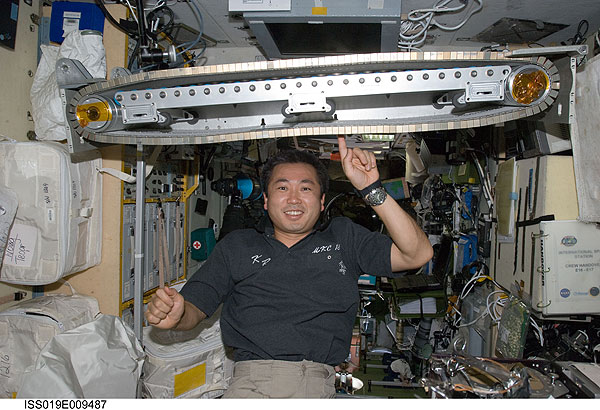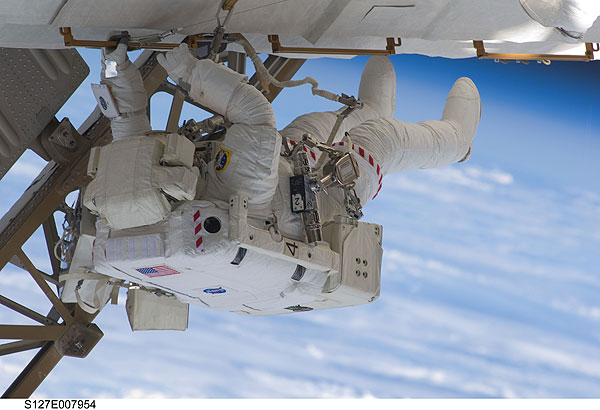Today, astronaut Michael Barratt discusses the pros and cons of artificial gravity. The University of Houston presents this series about the machines that make our civilization run, and the people whose ingenuity created them.
Contrary to what science fiction would have us believe, we cannot control gravity; we can neither create it nor switch it off. But we can provide an artificial acceleration that mimics gravity. A rotating structure creates angular acceleration, which gives rise to a centripetal force at the rim pushing back on an object that otherwise would fly off. (You may have experienced this on a spinning merry-go-round; it's easy to stand at the center, but you better hold on at the edge.) For spacecraft, this was described as early as 1928 by the Slovene space pioneer Herman Noordung. He envisioned a 100ft diameter rotating structure with a centralized airlock and crew quarters around the rim. The idea was brought vividly to the big screen in Stanley Kubrick's 2001: A Space Odyssey.
So we have an interesting situation, where on earth we are stuck with gravity, but in space we have a choice of emulating it or living without it in a weightless environment. There are of course tradeoffs. The force is related to the radius and the rate of spin; increase either one and you increase the apparent gravity, or G. You would need a structure with a radius of about 900m spinning at a gentle 1rpm to create the equivalent of 1 G. On the other hand, a 10m radius spinning at 10rpm would give about the same force, but such spin rates can be highly disorienting to the human sensory system. (And there are other effects.) Standing with your feet on the rim, the floor, you will experience higher 'gravity' at your feet than your head. Walking in the direction of spin, you increase your rotational velocity and get heavier; moving in the opposite direction, you get lighter. Most of these effects would be less noticeable in very large structures at slow rates. A practical structure might be smaller and offer less G.

Koichi Wakata demonstrating a key aspect of weightlessness. The treadmill belt he is balancing on one finger is quite heavy on the ground.
But there are positive aspects of weightlessness you would give up. Once adapted, a human can move himself and large objects almost effortlessly. In addition, the habitable volume increases from a functional standpoint. This was brought home to me during a two day's commute to the International Space Station in the tiny Soyuz spacecraft, which becomes much more livable when three dimensions are available. The station itself has storage and work areas arranged in all axes, which makes for very efficient use of space. And, we use artificial gravity nearly every day. We remove air bubbles from water bags by holding them and pirouetting around a central point; the same technique is used to eat a bag of pretzels without shedding crumbs. You can slowly swing an arc with your arms to retrieve a single object from a plastic bag, then close it before the contents fly out. In essence we do control artificial gravity, turning it on and off on a very local scale.
Ultimately, we likely will build large rotating space structures. The positive effects for the human and for systems operating in familiar conditions are too enticing. But for travel beyond earth vicinity, the ultimate artificial gravity will be linear, along a line of constant acceleration provided by new engines producing continual thrust. This of course unless we really do one day learn to control gravity'

A spacewalk in progress on the truss of the International Space Station. Imagine conducting such activity on a rotating structure.
I'm Michael Barratt for the University of Houston, where we're interested in the way inventive minds work.
End Notes:
The ability to control gravity, allowing crewmembers of a future starship to walk normally about their decks or to allow objects to float in an artificially controlled field, is deeply ingrained in the world of science fiction and into our psyches. The effect is a strong assumption that such technology exists or will soon, so much so that we are occasionally asked at NASA where our zero gravity room is. The truth is that while we can describe and measure the influence of gravity, an attractive interaction between masses, we cannot as yet alter its behavior. We can however alter the effect of the resulting acceleration. But first, a word about the terms 'g' and 'G'.
We use the small letter g to denote the acceleration on an object, such as you, due to earth's gravity at the surface. This is 9.8 meters/second2, which together with your mass gives you your weight. The large letter G denotes multiples of g, and so really has no dimensions of its own. But it is useful for describing acceleration environments. For instance, launching into orbit, you might experience 3 or 4 G's for a period of time, during which you will effectively weigh 3 to 4 times your normal body weight. A fighter pilot might experience 8 or 9 G's during a very tight turn in a high performance aircraft; the turn creates the angular acceleration described in the broadcast. Just imagine the circular course of the turn as a small section of the spinning wheel of a large rotating space station. You definitely don't want to stay at these high G levels too long; blood drains from your head and your arms become very heavy. We are of course looking for much more sanguine G levels in space, closer to earth normal.
Once we get into orbit, we feel weightless, experiencing what we sometimes call 'zero G'. But this is not 'zero g'; the influence of gravity is very much with us and keeps in orbit around the earth rather than flying away into space. It is the continual freefall around the earth that gives us weightlessness; gravity pulls us into a fall toward the center, but this is balanced by our forward velocity around the earth.

Mike Barratt in the Soyuz spacecraft. It was amazing how much larger this small capsule seemed once in weightlessness.
We have known for many years that the weightlessness experienced during orbital flight would make many things difficult, from handling fluids to keeping track of objects. At the same time, the human body would find itself under-loaded, resulting in loss of bone and muscle during prolonged flight. Herman Noordung, actually a pseudonym for Herman Potocnik, may have been the first to describe this in formal written text. His book, The Problem of Space Travel: The Rocket Motor is actually a brilliant and comprehensive treatise on space travel and structures, preceding the first human space flight by many decades. His 100ft or 30m diameter structure would have had to rotate at about eight rpm to give 1G, a spin rate which most likely would have caused significant sensory discombobulation. But the concept is sound and has stuck with us, and rotating structures in space will most certainly be realized one day. These have taken the conceptual forms of large wheel-like structures, capsules connected by long tethers rotating around a central point, and very short-arm human centrifuges that give large loads for short, intensive periods of G loading.
But the artificial gravity induced by rotation is not a panacea. It presents engineering and operational problems that have to be balanced against the mechanical and medical benefits. You have to spin up a large structure, requiring energy, and may have to spin it down periodically for maintenance and repair. We have often performed space walks to build or fix components of all the space stations which have existed, and these would be nearly impossible on rotating structures. Items destined for the weightless environment can be lighter than those built the gravity environment, an important consideration with a high cost to orbit per pound. From a purely hedonistic standpoint, flying within the spacecraft cabin is simply the most wonderful experience! The ability to move large objects and position them precisely, especially when they are very delicate and expensive, is quite comforting. And interestingly, we are at a period of human spaceflight where we are getting better at maintaining the human body during long periods of weightlessness. Advanced exercise machines, optimizing diet and nutrition, and other means are being developed and show promising results in returning crewmembers in a fairly fit state after 6 months of flight.

The Expedition 20 crew at the galley table of the International Space Station. Having all three dimensions freely available makes the volume much more usable. We have had as many as 13 crewmembers for dinner in this space with plenty of room.
In the future, engineering solutions will inevitably catch up with the challenges and make large rotating stations feasible and practical. Most likely these will be positioned at endpoints along our well traveled routes, such as between earth and Mars. I believe we can also count on the engines which carry us between these points getting us there in a short enough period that artificial gravity is not needed to maintain the human en route.
Biography:
Michael Barratt is a NASA astronaut and physician, with specialties in internal and aerospace medicine. He came to the Johnson Space Center in 1991, where he worked for 9 years as a project physician and space flight surgeon. Working with the joint US / Russian programs involving the Space Shuttle and the Mir space station, Dr. Barratt was able to work with a new set of colleagues in the Russian space medical community. Selected as an astronaut in the class of 2000, Dr. Barratt made his first flight in 2009 aboard a Russian Soyuz, and spent 199 days in flight during a tour of duty on the International Space Station. He remains active in the space medical community, serving as associate editor for space medicine for the journal Aviation, Space, and Environmental Medicine, and is senior editor of the text 'Principles of Clinical Medicine for Space Flight'.
References:
Herman Noordung. Das Problem der Befahrung des Weltraums: Der Raketen-Motor (The Problem of Space Travel: The Rocket Motor) Berlin: Richard Carl Schmidt and Co, 1929
Barratt, M. Physical and Bioenvironmental Aspects of Human Space Flight. In: Principles of Clinical Medicine for Space Flight M. Barratt, S. Pool, editors. Springer-Verlag, New York 2008